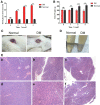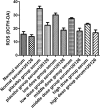Effect of diabetes blood-stasis syndrome and Xuefu Zhuyu decoction on ROS-ERK1/2 signaling pathway in rat retina Müller cells
- PMID: 32112164
- PMCID: PMC7192990
- DOI: 10.1007/s10616-020-00379-7
Effect of diabetes blood-stasis syndrome and Xuefu Zhuyu decoction on ROS-ERK1/2 signaling pathway in rat retina Müller cells
Abstract
This research aimed to investigate whether diabetic blood-stasis syndrome had a relationship with ROS-ERK1/2 signaling pathway in rat retina Müller cells and explore the effects of traditional Chinese drugs designed for promoting blood circulation to remove blood stasis on diabetic retinopathy (DR) treatment. Immunofluorescence was applied to determine purity of Müller cells. The diabetes was induced in rats by streptozotocin (STZ). Müller cells were stimulated by blood serum obtained from rats with blood-stasis syndrome and then treated by Xuefu Zhuyu decoction. Kits for reactive oxygen species (ROS), superoxide dismutase (SOD) and glutathione (GSH) were used for corresponding detection. Western blot analysis was used to determine the phosphorylation of ERK1/2. The results indicated that stimulation of Müller cells by blood serum of rats with diabetic blood-stasis syndrome increased the expression of ROS, inhibited SOD and GSH, and activated ERK1/2 signaling pathway. Treatment of Xuefu Zhuyu decoction could weaken this phenomenon. What's more, similar effects of ERK1/2 inhibitor U0126 with Xuefu Zhuyu decoction proved the involvement of ERK1/2 signaling pathway. Therefore, our results suggested that traditional Chinese drugs for promoting blood circulation to remove blood stasis would be an effective therapy to treat DR.
Keywords: Blood-stasis syndrome; Diabetic retinopathy; ERK1/2 signaling pathway; Müller cells; Reactive oxygen species.
Conflict of interest statement
The authors declare no conflict of interest.
Figures






References
-
- Ahmad I, Del Debbio CB, Das AV, Parameswaran S. Müller glia: a promising target for therapeutic regeneration. Invest Ophth Vis Sci. 2011;52:5758–5764. - PubMed
-
- Antonetti DA, Barber AJ, Bronson SK, Freeman WM, Gardner TW, Jefferson LS, Kester M, Kimball SR, Krady JK, LaNoue KF, Norbury CC, Quinn PG, Sandirasegarane L, Simpson IA. Diabetic retinopathy: seeing beyond glucose-induced microvascular disease. Diabetes. 2006;55:2401–2411. - PubMed
-
- Barber A, Antonetti DT. Altered expression of retinal occludin and glial fibrillary acidic protein in experimental diabetes. The Penn State Retina Research Group. Invest Ophth Vis Sci. 2000;41:3561–3568. - PubMed
-
- Baynes JW. Role of oxidative stress in development of complications in diabetes. Diabetes. 1991;40:405–412. - PubMed
-
- Boldt S, Weidle UH, Kolch W. The role of MAPK pathways in the action of chemotherapeutic drugs. Carcinogenesis. 2002;23:1831–1838. - PubMed
Grants and funding
LinkOut - more resources
Full Text Sources
Miscellaneous

